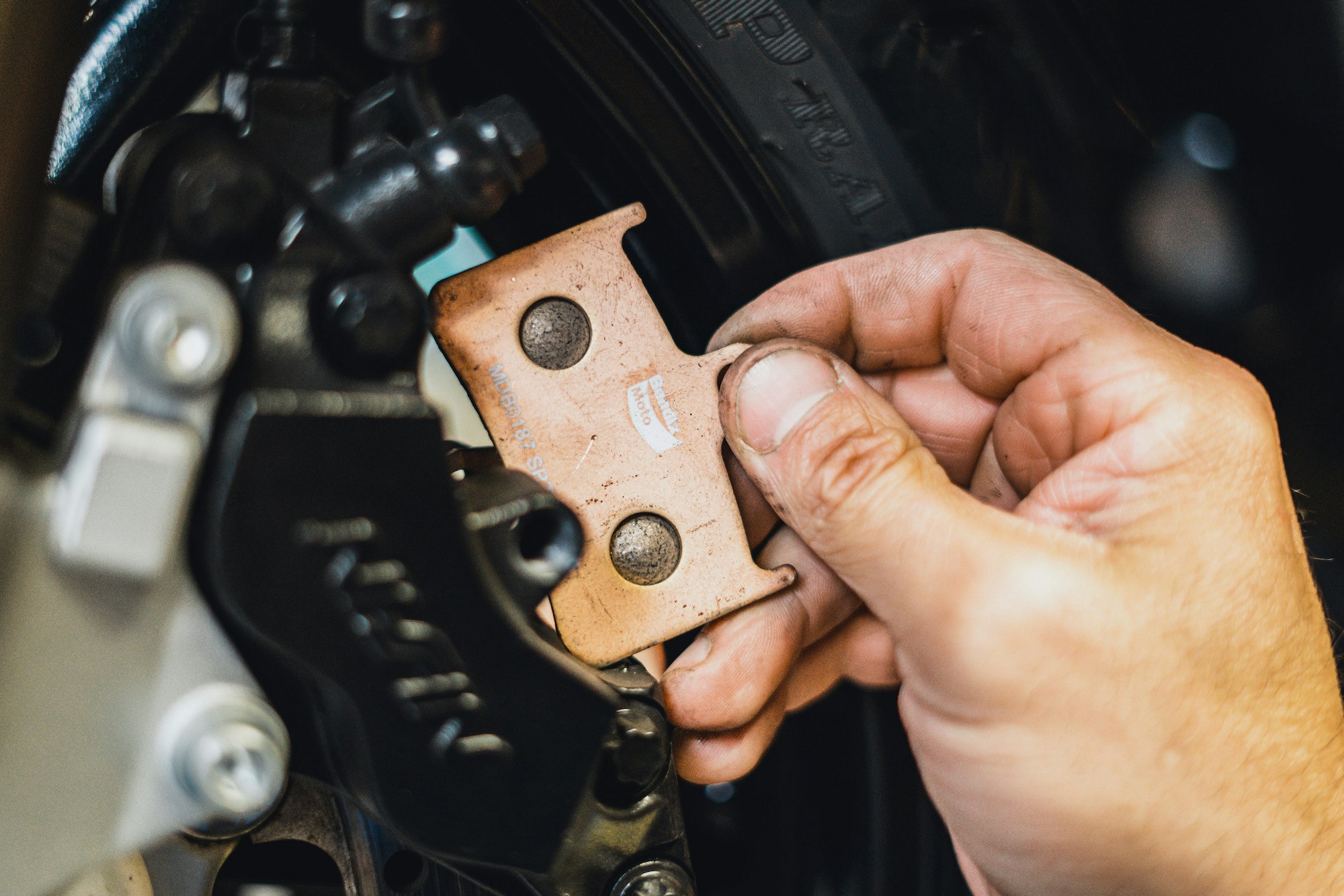What causes uneven motorcycle brake pad wear
October 4, 2022 Tips & how-to guides
Motorcycle brake pads wear out but front pads wear out faster than rear pads. These are the simple facts of life on two wheels. When your bike is in the shop for its regular service and a brake inspection reveals the brake pads show uneven wear, what happens next?
In the regular course of events, a skilled mechanic will point out the problem and make the repair.
Read on if you're wondering what causes uneven brake pad wear and would like to know how the problem gets fixed.
Several possibilities can cause uneven brake pad wear. Here are the steps a professional mechanic will take to troubleshoot the problem. Plus, the methods needed to return your brakes to A1 condition.
Five Main Reasons for Uneven Brake Pad Wear:
Disc Thickness Variation (DTV)
Defective Caliper Slide Pins
Broken or Worn Spring Clips
Uneven Piston Pressure
Incorrect Brake Pad Fitment

Disc Thickness Variation
Disc Thickness Variation is a problem that arises from the disc rotor either warping from overheating or wearing irregularly. Without a flat surface to press against, the disc pads will wear out faster and more unevenly than usual.
Fix: Removal and careful measuring will reveal if the disc rotor surface is at fault. The disc will need machining or replacing with a new one to cure this problem. This particular problem is also associated with vibration when the brakes are applied. You can find more detailed information about the causes of brake vibration here. (Link to vibration article)
Defective Caliper Slide Pins
Slide pins play a pivotal role in the safe function of a motorcycle's brake system. When pressing the brake lever, the brake piston forces the pads towards the disc. This action causes the caliper slider frame to travel along the slide pins.
These pins may become defective from wear, corrosion, or damage resulting in the slider frame jamming on the pins. Also, this action leads to uneven pressure mirrored in the brake pad, which then pushes against the rotor at an angle.
Fix: It is necessary to remove the caliper's steel slide pins for inspection and to assess the damage. Most corrosion is removable by a wire wheel. Alternatively, excessive wear or damage may result in the need for new slide pins. Installation of the new pins using a liberal coating of Bendix Ceramic High-Performance Synthetic Lubricant will help keep future corrosion at bay and reduce wear.

Broken or Worn Spring Clips
Brake clips are spring steel brackets located between the pads and the disc rotor. Once the pressure gets taken off the lever, the spring clips' role is to push the piston back in its bore.
A broken or worn spring clip may cause the brake piston to be pushed back at an angle. When the brake is next engaged, the piston will advance at an angle towards the disc.
Fix: Worn or damaged spring clips will need replacement. In addition, any re-assembling of the caliper should include Bendix Ceramasil Brake Parts Lubricant on all moving brake caliper hardware, including rubber components.
Uneven Piston Pressure
As mentioned earlier, the brake pads are forced against the disc rotor by the action of the piston. So, to make sure the travel and action of the piston are as linear as possible, the piston and bore must be a tight fit.
If road grit gets lodged in the bore, it can score the cylinder. Neglect regular maintenance for long enough, and the piston and bore can suffer from corrosion. When this happens, seizing occurs. This process can cause the piston to become pushed out unevenly and uneven brake pad wear is the result.
Fix: The mechanic will need a caliper strip to release the brake piston(s) from the bore. If surface corrosion is not too advanced, it is possible to clean and replace the piston(s). On the other hand, find any deep scores, and a replacement piston kit is needed. Either way, you can guarantee easier re-assembly and a longer working life using Bendix Ceramasil.
Incorrect Brake Pad Fitment
As a final word on the subject, uneven brake pad wear may be due to incorrect fitting. If the pads are misaligned, irregular wear is inevitable.
Fix: Insisting your mechanic using Bendix replacement brake pads will help prevent misalignment. These pads are a precision fit for your make and model of motorcycle and exceed original equipment manufacturer (OEM) specifications and performance.
For commuters, scooters, lightweight or classic bikes, you need Bendix Moto Ultimate+ ceramic pads. These low dust, low noise brake pads reduce rotor wear and give an increased feel at low and moderate speeds.
For heavy-duty cruisers, tourers, sports and dirt bikes, choose the Bendix Moto Street Road Track (SRT) pads. These sintered pads can handle wet, dry, hot, cold, or muddy conditions. In addition, they are stable, strong, low-fade and offer a strong initial bite. What's more, when performance matters, they are the best option.
Regardless of the reason, uneven brake pad wear means that your motorcycle's brakes are not working at full capacity. This reduced brake function is dangerous. Putting the problem right is often beyond the skill set of the average rider. Yet, visiting a skilled mechanic using Bendix brakes pads and brake products is the best way to help guarantee safe, secure, stress-free stopping.
Bendix Motorcycle Brake Products
Bendix Moto offers a wide range of consumables, including Ceramic Ultimate+ and Street Road Track Sintered motorcycle brake pads, specialists caliper lubricants and DOT3 and 4 brake fluids.
 Australia
Australia
 New Zealand
New Zealand